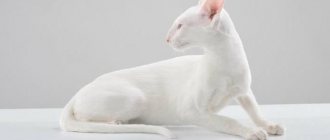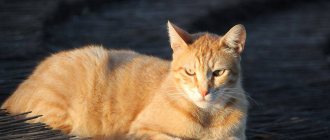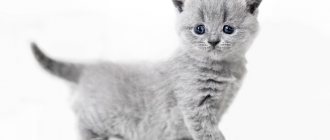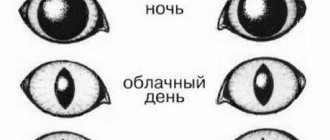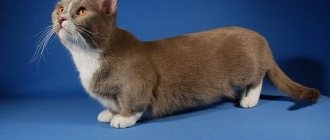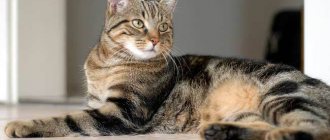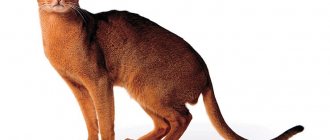If your cat sheds a lot, and her fur flies everywhere, lies on the floor, sticks to furniture upholstery, clothes, and even gets into her food, it’s time to think about starting to comb her beauty. This process is very important and is one of the main caring procedures. It helps not only to remove dead hairs from the surface of the animal’s fur coat, but also eliminates dried dirt, tangles, parasites and their waste products. In addition, manipulation prevents your pet from eating tufts of fur and developing intestinal obstruction. How to properly comb a cat?
Shedding in a cat is a natural process. How to properly comb a cat?
Why do cats shed?
Shedding is a natural process that is typical for any age and different breed. Even cats such as Sphynxes cannot do without the process of hair renewal. Of course, long-haired pets cause more trouble for their owners than their short-haired counterparts.
Cat owners need to understand that it is useless to fight shedding. Here you can only influence the intensity of hair loss and the condition of the fur.
The cat is shedding
It is worth noting that molting in cats occurs seasonally, that is, 2 times a year - in spring and autumn. The process is first observed at six months of age. During this period, the animal loses its soft coat, and in its place, stiffer hairs, characteristic of an adult, are formed. In addition, a beautiful outlined pattern appears on the fur, and the point becomes more expressive.
Domestic cats are also prone to shedding. In long-haired beauties, this process is more intense in the spring. In autumn, hair loss is not so noticeable. In short-haired breeds, shedding occurs more evenly. The period lasts from 2 to 4 weeks. During this time, the animal acquires a new coat.
A cat that cleans up after itself is every owner's dream
Types of cat fur
Felines vary in length and thickness of fur. Their care and how many times they need to be combed depend on these distinctive features.
Short-haired cats (breeds: Siamese, Rex and others) practically do not need coat care. If you are wondering what you should use to brush your short-haired cat, then it would be right to give preference to a mitten.
Long-haired dogs (Persians, Angoras, etc.) require daily care, otherwise the hairs may become tangled. Therefore, you need to comb them often.
Semi-longhaired dogs (munchkins, bobtails) also need frequent brushing.
Sphynxes are cats with virtually no fur. There is no need to comb them, but skin care is necessary.
Also, cats may or may not have undercoat. Cats with undercoat require more frequent and thorough brushing.
Causes of severe shedding
But not all cats shed according to the season. Many owners of furry cats complain that their pet “throws” its fur all year round. The reason for this is the constant presence indoors. The fact is that the cat simply stops feeling seasonal changes, since the microclimate in the house is almost always the same. Another reason for prolonged “apartment shedding” is the heating season in the winter-spring period.
The source of excessive hair loss can be severe stress - moving, changing owners, switching to a different diet, adding another animal to the house, visiting a veterinary clinic, etc.
The cat is sick
Improper care and unbalanced nutrition also lead to severe hair loss in cats. A lack of vitamins and minerals and a mono-diet primarily affect the condition of the coat and disrupt the natural process of coat renewal.
The same applies to incorrectly selected care products. If, after using a new shampoo, you notice that the animal’s fur has begun to fall out or change in some way (for the worse), then it should be replaced with another product.
Rating of cat shampoos for different purposes
Often, severe shedding occurs due to diseases - allergies, ringworm, dermatitis, etc. Often, intense hair loss is a symptom indicating a malfunction in the animal’s body.
Both uncastrated cats that are not allowed to copulate, and cats that have just given birth can suffer from severe hair loss. This category also includes cats who are already nursing kittens.
Why do you need to comb cats?
Over the course of months, unkempt fur results in unsightly tangles. If you continue to ignore the combing procedure, the fur coat will no longer be similar to the previous one, but will turn into a hard shell. Imagine how difficult this will make the animal’s life—you won’t be able to wash yourself or scratch yourself. Why scratch it, the poor animal can’t even stretch properly.
Neglected case
But this is just part of the problem. Next, an inflammatory process will begin to develop under the shell, and for bacteria this situation is simply ideal. As a rule, it is at this moment that the owners begin to fuss, looking for an answer to the question: “Who infected my cat?” Although the thought that all this could have been prevented by brushing the pet daily, of course, will never occur to them.
They will be informed about the need for the procedure by a veterinarian, who will come with a clipper and trim the coat of the once beautiful Angora or Persian under anesthesia. In addition, during the conversation it turns out that the fight against mats was constantly carried out with the help of a special shampoo, the label of which read “To remove mats.” It's worth noting that this is just a publicity stunt. Shampoo for tangles is used only for preventive purposes, and once they appear, the product is absolutely useless and even harmful.
Freeing a cat from tangles
After removing the shell, the veterinarian will explain to the owner that combing should be done daily with special brushes and combs. Moreover, long-haired beauties must go through this procedure several times a day during the molting period. As for their brothers with a short fur coat, you can get by with once every 2 days.
You don't need to bathe your cat often either. Once every 2 weeks is enough for heavy shedding. If the pet itself does not mind, then the procedure can be performed more often.
It is worth saying that tangles are not so catastrophic. The trouble is that the cat will zealously lick the dead hairs. What can you do here - it’s laid down by nature. This cannot be done without the hairs from the mouth getting into the stomach. Can you imagine, if the shedding is intense, and the pussy has long hair, then in what quantities does it penetrate the gastrointestinal tract? Many will ask: “Well, what’s the big deal, just throw up once and that’s it?” Not all. Hairballs that get into the stomach can cause intestinal obstruction, and then it’s not far from the operating table.
The cat clears its stomach of fur
Therefore, combing is a very important procedure, which allows you not only to remove dead hairs, but also parasites, as well as their metabolic products. In addition, regular brushing will help:
- Clean your apartment from fur less often;
- resist eating falling hairs;
- prevent stomach and intestinal congestion;
- speed up blood circulation and metabolism;
- prevent and get rid of tangles;
- grow wool beautiful and strong.
In order for the procedure to be as useful as possible and bring a lot of pleasure to the cat, it should be carried out correctly.
Many cats enjoy brushing
Slicker comb: the most popular
In order to comb out dead fluff without affecting the strong guard fibers, you will need a so-called slicker, or slicker.
The peculiarity of the slicker is in its teeth. They are metal, thin, with a characteristic bend. Depending on the quality of your pet’s coat, you need to choose a slicker brush: the thicker and longer the coat, the longer and more frequent its teeth.
You should not try to deal with matted hair using a slicker. It is intended only for the care of healthy hair, previously combed with a wide-tooth comb.
When your cat sheds, refrain from brushing her coat with a slicker every day. Twice a week will be enough. More frequent use will turn your fluffy beauty into a pitiful, shabby creature. After the shedding period ends, use this useful tool once a week.
Despite the popularity of the slicker, it is only one of many tools needed to care for your pet.
Which comb to choose
We think that there are more than enough arguments proving the benefits of combing. To ensure high-quality care for your pet’s fur, you should take care in choosing a tool, that is, a comb, a brush. There are many varieties of such devices. How not to make a mistake and make the right choice?
The choice will directly depend on:
- length of the animal's fur;
- her condition;
- purposes of combing (removing parasites, getting rid of dead hairs, massage, etc.).
Basically, to get rid of old and unnecessary fur, they use:
- a brush with bristles made of natural materials;
- mitten;
- furminator;
- brush;
- crest;
- double-sided brush;
- powder brush, etc.
Brushes with bristles made from natural materials
Natural bristle brushes have a good advantage. Bristles, when exposed to fur hairs, do not create static electricity and do not electrify it. And this is very important. After all, the cat monitors the condition of its coat very carefully. If its fur sparkles while brushing, this will give the cat a lot of negative emotions. Next time she is unlikely to voluntarily agree to this procedure.
Attention! You should not buy a cat comb with plastic or plastic teeth. They will make your pet's fur very electrified.
Brush with natural bristles
Mitten
The mitten is suitable for both dry and wet fur coats. On its surface there are rubber or metal teeth of various lengths. The mitten perfectly massages the animal’s skin, thereby improving blood circulation and metabolism, and the coat becomes shiny and healthy in appearance.
But this brush is not suitable for complete removal of dead hair. It is not used to comb the fur, but to remove hairs that are ready to fall out. It is more advisable to use this device at the final stage of combing or if your cat completely refuses to comb with other tools.
Comb-mitten of two types
Fine-tooth comb
The combs are suitable for daily grooming of cats. Such devices will help not only remove all dead hairs, but also get rid of parasites. A comb is an ideal tool for evenly combing outer hairs. It can also be used in the presence of tangles and matted fur.
Comb with rare metal teeth
Double-sided brush
A double-sided brush is a very convenient and versatile option that replaces several devices for combing cats. On one side of the tool there are bristles made of natural or artificial material, and on the other there are metal rounded teeth.
Double sided brush
Puhoderka
A special feature of the slicker is its teeth. They are made in such a way as not to touch the hard (guard) fibers. The teeth are made of metal, rounded at the ends. You should choose such a tool depending on the length of your pet’s fur. The higher and thicker it is, the larger the teeth should be.
It is worth noting that the slicker is not used in the case of “shell” or matted wool. It is used only for a healthy coat or after combing with a rare-tooth comb. You should not use this brush every day. Enough 2 times a week during the molting period. If you use it more often, it threatens to turn your beautiful cat into a shabby miracle. After the end of the molting period, the slicker is used no more than once a week, or even less often.
Puhoderka
Furminator
The Furminator is perhaps one of the most popular for combing wool. It is a tool that resembles a small rake. There are two types - deluxe and classic. They differ in comb size and appearance. So, for adult cats, a comb 4–6.8 cm wide is required. For kittens, 3.2 cm is enough.
Furminators are available with teeth of various lengths, which makes it possible to choose a tool specifically for your animal’s fur coat. Many owners note that after using this device, the amount of hair falling out is noticeably reduced, and the coat looks healthier, well-groomed and beautiful.
Furminator
Attention! If there are wounds, abrasions, or scratches on the furry skin, then furminators cannot be used.
Unlike their long-haired counterparts, caring for short-haired cats is quite simple. It is enough to comb them once a week (during the molting period, once every 2-3 days). To care for the short coat of animals, it is recommended to use such brushes.
Table 1. Combs for short-haired cats.
| Comb | What is it used for? | Note |
| With short teeth and plastic handle | Used for short coats with fine hairs. With its help, you can comb out not only unnecessary hairs, but also any parasites, as well as dried dirt. | Number of teeth - 49. Price - 120 rubles. |
| With thick teeth close to each other. Plastic handle | You can remove parasites and their metabolic products, as well as dried dirt. Suitable for delicate, smooth, fine wool. Attention! You need to watch your teeth. If they lose their original appearance, become distorted, they will begin to tear out the fur. | Number of teeth - 49. Price - 140 rubles. |
A rubberized comb and furminator are also suitable for combing beauties with short fur.
Rubberized comb
Before the procedure, walk over your cat's coat with a damp hand. This will prevent the wool from flying in different directions. After this, use a comb several times - run along the hair growth - from the scruff to the tail. If your cat does not experience discomfort, then you can brush against the grain. This will remove unnecessary hairs much faster. If the animal actively resists, do not insist. Perhaps he is uncomfortable or in pain. Next, you need to use a massage brush or mitten to remove loose hairs or a damp palm.
This cat loves being brushed
Grooming skills
The period of molting becomes almost a test for every owner; it is then that the question of how to properly comb a cat becomes acute. Pets with short coats will need to be freed from excess hair every 2-3 days. The furry animal will need to be cared for daily.
To make the process more effective, you need to act against the grain. To begin with, you should arm yourself with a brush with sparse teeth, gradually moving on to those with denser teeth.
Some people wonder how to comb out a cat's undercoat. If you direct the movements against the grain, then for some breeds this approach will be ideal. However, if we talk about the Scottish one, then such a decision will turn out to be wrong, just like the use of a slicker. This can lead to damage to the dense undercoat, and sometimes to the formation of bald spots. If the cat has this area that is prone to falling off, then regular treatment with a brush or mitten will be required.
After the procedure, it is important to moisten your hand in water and run it over the animal against the hair growth. This way you will be able to get rid of any remaining fur. Accustoming to such manipulations should be done when the kitten reaches six months of age.
How and with what to comb long-haired cats
Cats with long and semi-long hair should be brushed every day. During molting, the procedure should be carried out 3-4 times a day. It is preferable to use the following comb options:
Table 2. Combs for cats with long hair.
| Comb model | Methods and areas of use | Note |
| Hallow Pet's side splitter (mini) | Used to remove tangles. It is a device with curved teeth-blades. | Number of teeth - 8. Handle with thumb rest. The blades are made of stainless steel. Price — 435 rub. |
| Slicker Ferplast GRO 5944 Medium | The teeth of the slicker of this model are curved at the ends. Frequently located. The tool is used only for the fluffy tail, collar area and panties. Suitable for all breeds. | The bristles of the slicker are made of steel. The set includes a comb that removes hairs from the slicker. Product color: red, black. Price - 430 rub. |
| Hello Pet brush with iron teeth | Used for combing the area of the tail, collar, and pants. | Very light, does not slip on your hand. The teeth are rounded, do not scratch, are not pressed into the animal’s skin and do not fall out. The handle is made of wood. The height of the cloves is 2 cm. Price is 517 rubles. |
| Comb with teeth of various lengths Furminator Ferplast | Suitable for all types of wool. Does not damage guard hairs. Attention! For fluffies, furminators are considered the most acceptable (in terms of comfort and painlessness). | The tips are rounded at the ends. The pressure of the teeth on the cat's skin is minimal. Price – 990 rub. |
| Comb with teeth of various lengths | Used for tight, dense hairs and the same undercoat. With its help, the fur coat can be styled and fluffed. | The handle is made of plastic, the teeth are made of metal. Elegant design. Price – 480 rub. |
Attention! Many cats don't like their tails being touched. And this is no wonder, because the tail is one of the most sensitive places in animals. Therefore, if during the process of combing the cat does not allow you to touch it, do not insist. After all, the tail is the area that “throws” fur around the apartment the least.
Combing a long-haired cat with a comb with metal teeth of various lengths
How to comb your pet?
How to comb a cat is an important question. An ordinary human comb will not work, because animal hair has a different structure from human hair. Therefore, you need to purchase a special comb. Pet stores have a large selection of cat brushes.
- Furminator. This is a rectangular comb with teeth and a rubberized handle. Ideal for combing an animal when shedding, it effectively removes dead hair from the animal. In addition, with a furminator you can give the animal a kind of massage: accelerating the blood and balancing the layer of fat throughout the body. Owners who often wonder how to comb out a cat’s mats will also benefit from this device.
- Mitten. It is a mitten equipped with teeth or pimples. Worn on the hand. The owner can only run his mittened hand over the animal’s fur. This mitten is convenient for brushing a smooth-haired or short-haired cat. Even if the animal usually does not give in and interferes with the combing procedure, it will not be able to do anything against the mitten.
- Pukhoderka. Comb with teeth. There are several varieties depending on how long the teeth are and how often they are set, straight or curved. If your cat has long hair, it is better to choose a slicker brush with long, close-toothed teeth.
- Scallop. A comb with teeth of different lengths is good for shedding, and is also used when combing out parasites.
- Double sided brush. This is both a comb and a massager - depending on which side you turn it.
How to comb out correctly
There are 7 actions that will allow you to get the maximum benefit from combing.
- Scratch from tail to head. Comb hard guard hairs and soft undercoat in the direction opposite to the growth of the coat (but do not insist if your pet resists!). This will rid your pet of dead hairs much faster.
- Sequencing. Long-haired breeds need to be brushed first with a wide-toothed brush, then with fine-toothed brushes (closely adjacent to each other). The manipulation is completed by using a mitten or a cylindrical brush to remove all unnecessary hairs.
- Combing time. Depends on the length and thickness of the coat. Long-haired pets should be scratched for at least a quarter of an hour. Grooming a cat with a short coat takes significantly less time – 10 minutes.
- Tummy. Scratch this area after turning your pet onto its back. If he actively resists, leave this idea. Ask family members for help. Have someone grab the cat's front paws and lift him up. In a standing position, the tummy and “pants” are also easy to comb.
- Accuracy. In the area of the collar, armpits and panties, comb carefully, since in these areas the hair tends to clump, which causes pain during the procedure.
- If tangles have formed on the animal's fur, they must first be removed. Otherwise, combing will be useless and will bring a lot of unpleasant sensations to the cat.
Important! Take a basin of water, wet your hand and run it along the animal’s back several times. Then proceed to treat other areas of the body. Continue until there is not a single hair left on your hand. This is a very good way to get rid of unnecessary hair (even without the help of a brush!).
Video - How and with what to comb a cat
How to comb a cat's fur at home
A caring owner knows how to brush a cat well. It is advisable to accustom your kitten to hygiene procedures from a very early age. Then he will not be afraid of brushing and, perhaps, will even be able to enjoy it. It’s also not too late to teach adult fluffies to be brushed, but they will need more time to get used to it. If the furry beauty enjoys being combed, this procedure will not cause any inconvenience to anyone.
The Scottish breed is the most shedding
If any irritation appears on the skin, it is better to postpone combing until it heals. You need to start treating dermatitis, allergies, and fungal diseases as quickly as possible. Under no circumstances should you touch the wound with a comb.
The hand should move smoothly and gently. Do not press the comb too hard or make sudden movements, as this can damage the hairs and scare the cat.
How to comb a cat, step by step instructions:
- You need to stroke the cat with a mitten or run a wide-toothed comb through the fur.
- You need to start combing with a mitten, then use a furminator and a slicker, then different combs. It is advisable to complete the procedure with a massage comb and a brush with natural bristles.
- First, comb along the hair growth, and then against it. This effectively cleans the coat.
- Within a few minutes you need to comb the back, sides and tummy.
- It is worth paying a lot of attention to hard-to-reach areas. Take turns combing the “pants” near each paw, then the back of the head and withers.
- The smallest combs will be needed for combing the neck and the area around the ears.
- Small tangles need to be combed separately. They are moistened with spray and then smoothed using a comb. Large mats should be cut off by professional groomers with a special tool. It's better not to do this on your own.
- After combing, you should moisten your hand with water and stroke the cat with it.
The entire procedure will take no more than 5–10 minutes, but it will bring a lot of benefits to the furry pet and its owners.
Important! If the kitten does not like to be brushed and begins to resist, you need to distract him with his favorite toy or treat. This also helps adult animals. Each cat has its own personality, so you need to be patient with them.
Even if the owner does not yet know how to brush a cat, he will quickly learn it. This requires a little patience. It is not at all necessary to contact a groomer; it is enough to know how to brush a cat at home and how it is done.
Special shampoos for long or short hair will help your furry pet be beautiful and make it easier to care for. It is very important to periodically treat your cat with green grass or sprouted oats. You can buy it at a pet store or grow it at home in a special box. Grass and oats are a natural gastric cleanser. In addition, cats love grass very much for its pleasant taste and aroma.
Brushing cats' fur is very beneficial for their beauty and health. Yes, not all cats like this procedure, but it must be carried out so that tufts of hair do not fly around the apartment, and the pet itself does not vomit licked hairs.
*Prices in the article are as of August 2020.
How to comb out correctly
There are 3 actions that will allow you to get the maximum benefit from combing.
- Scratch from tail to head. Comb hard guard hairs and soft undercoat in the direction opposite to the growth of the coat (but do not insist if your pet resists!). This will rid your pet of dead hairs much faster.
- Sequencing. Long-haired breeds need to be brushed first with a wide-toothed brush, then with fine-toothed brushes (closely adjacent to each other). The manipulation is completed by using a mitten or a cylindrical brush to remove all unnecessary hairs.
- A helping hand. Take a basin of water, wet your hand and run it along the animal’s back several times. Then proceed to treat other areas of the body. Continue until there is not a single hair left on your hand. This is a very good way to get rid of unwanted hair from kittens (even without the help of a brush!).
If tangles have formed on the animal's fur, they must first be removed. Otherwise, combing will be useless and will bring a lot of unpleasant sensations to the cat.
Video - How to properly comb a cat
Attention! Accustom your pet to brushing from childhood. There have been cases when adult animals refused this procedure.
Before starting the procedure, you should carefully examine the animal's skin. If abrasions, wounds, or cuts from claws are found on it, then it is better to stop combing for a while, otherwise there is a possibility of even greater damage to the skin, infection, and the development of an inflammatory process.
Let's start with the cat's favorite places
Veterinarians recommend choosing a moment for brushing when the cat is in a good mood. There is no need to pull your pet by the tail and threaten with a comb when he has just woken up or eaten. Nothing good will come of combing an animal while it is kicking, biting and screaming at the top of its lungs. You can hardly call such a procedure combing; rather, tearing out tufts of fur. And after such horror, the poor cat will never want to repeat the procedure, and at the sight of a comb he will convulse or climb onto the cabinet.
This is how some cats react to a hairbrush
It is better to carry out manipulation before feeding. After all, after the successful completion of the procedure, you can praise your pet by giving him his favorite treat. Only after this will the cat associate combing with something good and kind.
Why you need to brush your cat
When you start scratching a cat, you not only take care of its fur, but also get additional positive emotions from its mood. After all, this is at the same time a useful massage for the skin, which gives it the opportunity to breathe better. And also, a way to remove foreign irritants that have become embedded in the animal’s fur.
The most obvious benefit of this procedure for the owner himself is the well-groomed appearance of his cat, which is pleasant to look at. And of course in the condition of the apartment, because there is much less hair and dust.
How does animal fur work?
Do you already know what kind of fur cats have and what it consists of? It is structured very simply:
- Awn: This is long cone-shaped hair. They protect the cat's skin from injury and retain heat.
- Undercoat: This is short and fine hair. As a rule, they serve to preserve heat in the animal’s body and prevent it from freezing during the cold season. It is in the cold that active growth of undercoat hair, which is also called down hair, is expected.
- Whiskers and sensitive hairs: Whiskers, eyebrows, hairs located above the upper lip - thanks to them, cats have a pronounced sense of touch, which helps to analyze the environment. Also, they are on the tail and paw pads, it is due to them that pets easily hunt for moving prey.
How to care for cat fur
You should start caring for your cat's fur from the time he was a kitten. This is necessary so that the pet gets used to combing and does not worry, perceiving it as a form of communication with the owner.
But even an adult cat can be easily accustomed to this. Just stroke her with your hand along the entire length of the fur and strictly along the fur, in no case against it. And after that you can pick up the scratcher.
How to comb a cat's fur?
There are several types of objects that can be used to brush your pet.
- Brushes. They come in rubber and steel. Their teeth have a rounded appearance.
- Combs. Made from metal, plastic or wood. In appearance they differ in frequent and rare parting between the teeth.
- Terry cloth can be used perfectly for laying pile on a cat's fur coat. If there is no fabric, you can replace it with damp suede.
- Special gloves with roughness intended for massage.
Take a sparse comb in your hands and start combing the cat. After that, use frequently. A brush made of bristles perfectly removes static from your pet’s fur and gives the fur shine. It is necessary to complete the combing procedure with a brush made of rubber. It perfectly collects lost hairs.
How to train an adult cat to brush
Never shout at an animal, tie its paws, or hold it seven. Think about it, maybe the procedure is really very painful for him. Perhaps the problem is the wrong brushing tool, which tears out his fur or scratches his skin.
The mistake of many owners is surprise and persistence. So, if your neighbor told you a beautiful story that after combing his cat stopped shedding and now fur does not appear in the mouth, in the food, or in the air, then there is no need to quickly run to the store, buy a comb and use it on the cat. .
The cat saw a comb for the first time
In this matter, the main thing is gradualism. If you don’t want your pet to associate you with the notorious Freddy Krueger, and your comb with a sparkling metal hook, then start with this:
- Show the animal the comb. Let her smell it and understand that this item is absolutely safe.
- Maintain consistency. Every day at the same time, brush the fur for several minutes. Let the cat begin to take the procedure for granted.
- Start moving to the places that the cat most likes to touch - the neck, chin, cheeks, head. Then move on to more difficult to reach areas.
- Do not put pressure on the animal's body.
- If the cat resists, then at first use a massage mitten, and then move on to more effective combing tools.
- After each procedure, praise your cat and give her her favorite treat.
Remember that the animal cannot reach the ears, withers and back of the head on its own. So be sure to brush these areas.
All movements should be as smooth, gradual, and gentle as possible. Take your time. At the same time, caress the cat, speak quietly, praise him, call him by name. This procedure is a kind of unity with the animal, after which your cat will trust and love you even more.
Grooming is a real challenge for this Siberian cat
Attention! Under no circumstances put pressure on the comb, trying to grab as much hair as possible. This will cause pain to the cat and cause aggression. The animal simply will not allow the procedure to be completed, and it will be useless.
Furminators
One of the most popular tools for combing cat hair is the furminator.
Small rake with frequently set teeth - this is what this miracle tool looks like.
Furminators for cats are divided into two types: classic and deluxe. They differ in design and width of the ridges.
For small kittens, a 3.2 cm wide comb is suitable.
For small cats whose weight does not exceed 5 kg, a comb width of 4 and a half cm is sufficient.
The most popular width of the comb, which can be used not only in caring for a cat, but also for a small dog, is 6.8 cm.
Regardless of the width of the comb, furminators come with short and long teeth, which allows you to use them when caring for a cat of almost any breed. The only exceptions are those breeds whose coat is devoid of undercoat or has a specific shape: Devon Rex and Cornish Rex, Burmans, Singaporeans, Orientals, Turkish Angoras and some others.
If there are scratches or wounds on the animal’s body, as well as in the case of any skin disease, the furminator should not be used!
Anyone who has ever used a furminator notes that the cat’s hair loss has been significantly reduced, and its appearance becomes much better due to the fact that the fatty lubricant is distributed more evenly. Furminators are used by professional groomers, but nothing prevents you from mastering this tool yourself and providing your striped “Murka in a jacket” with the same care as an overseas beauty worth more than one thousand dollars.
Features of grooming British cats
If we talk about British cats, then the combing procedure should be carried out 1-2 times a week throughout the winter. The fact is that during this period of time, a dense undercoat forms on the fur coat, on which tangles can form.
The result of combing a British cat during a period of intense shedding
It is best to use a slicker with metal rounded, long and densely set teeth for combing fluffy British cats.
Attention! For the British, it is better not to buy a powder brush. If the undercoat is damaged, the coat of a cat of this breed will lose its attractiveness and will not seem plush.
Resourceful owners remove hairs with a damp hand. And it is right. This method can remove much more dead hair than any other comb. Of course, we are talking about daily care.
The importance of brushing
This procedure is very important and useful for your pet. This helps to regularly inspect your pet’s skin and, if necessary, take the necessary measures. When cats begin to shed, large amounts of hair are ingested during grooming, and this can lead to illness. Many people notice that during the period when hairs fall out profusely, the animal becomes more lethargic, sometimes even vomiting. These can be the consequences of improper hair care.
How to properly comb Scottish cats
Scottish cats are perhaps the only one of their kind - they can be scratched against the grain of their fur. At the same time, the likelihood of damage to the undercoat and dissatisfaction of the cat itself is small.
For Scottish straights and folds, it is preferable to use brushes with natural bristles or metal teeth with balls at the ends. The ideal option would be a double-sided comb.
It is recommended to comb Scots first according to the growth of their hair, then against it. It is better to remove the remnants of dead hairs with a damp palm. You need to start the procedure with a wide-toothed comb, then move on to using a brush made of natural material or a furminator.
Brushing a Scottish cat with a furminator
When not to comb
Combing the fur is very important to keep your pet healthy. However, there are situations when you should not use a furminator, and it is better to give preference to the most gentle options. You cannot use such a device if you have the following problems:
- skin diseases or irritations on the integument;
- presence of scratches or abrasions.
You should be very careful with existing tangles; combing is done carefully so as not to cause pain to your pet. It is prohibited to use a Furminator if the cat does not have undercoat or is a curly breed.




